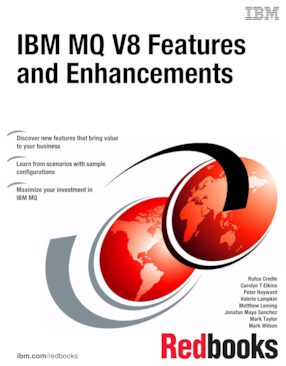About cookies on this site Our websites require some cookies to function properly (required). In addition, other cookies may be used with your consent to analyze site usage, improve the user experience and for advertising. For more information, please review your options. By visiting our website, you agree to our processing of information as described in IBM’sprivacy statement. To provide a smooth navigation, your cookie preferences will be shared across the IBM web domains listed here.
IBM MQ V8 Features and Enhancements
An IBM Redbooks publication
Published 02 October 2014

ISBN-10: 0738439932
ISBN-13: 9780738439938
IBM Form #: SG24-8218-00
(332 pages)
View online
Authors: Rufus Credle, Carolyn Elkins, Peter Hayward, Valerie Lampkin, Matthew Leming, Jonatan Maya Sanchez, Mark Taylor, Mark Wilson
Abstract
The power of IBM® MQ is its flexibility combined with reliability, scalability, and security. This flexibility provides a large number of design and implementation choices. Making informed decisions from this range of choices can simplify the development of applications and the administration of an MQ messaging infrastructure.
Applications that access such an infrastructure can be developed using a wide range of programming paradigms and languages. These applications can run within a substantial array of software and hardware environments. Customers can use IBM MQ to integrate and extend the capabilities of existing and varied infrastructures in the information technology (IT) system of a business.
IBM MQ V8.0 was released in June 2014. Before that release, the product name was IBM WebSphere® MQ.
This IBM Redbooks® publication covers the core enhancements made in IBM MQ V8 and the concepts that must be understood. A broad understanding of the product features is key to making informed design and implementation choices for both the infrastructure and the applications that access it. Details of new areas of function for IBM MQ are introduced throughout this book, such as the changes to security, publish/subscribe clusters, and IBM System z exploitation.
This book is for individuals and organizations who make informed decisions about design and applications before implementing an IBM MQ infrastructure or begin development of an IBM MQ application.
Table of contents
Part 1. Introducing IBM MQ V8 and new features
Chapter 1. Introduction
Chapter 2. Topic host routed publish/subscribe
Chapter 3. User authentication
Chapter 4. TLS/SSL Digital Certificate Management
Part 2. New for z/OS
Chapter 5. Buffer pool enhancements
Chapter 6. Extending the log RBA and conversion
Chapter 7. SMF changes: Channel initiator statistics and channel accounting
Chapter 8. Using new System z features
Part 3. Scenarios
Chapter 9. Topic host routed publish/subscribe scenarios
Chapter 10. Authentication scenarios
Chapter 11. CHINIT SMF scenarios
Chapter 12. Advantages of a buffer pool above the bar
Chapter 13. SCM scenarios
Chapter 14. zEDC scenario
